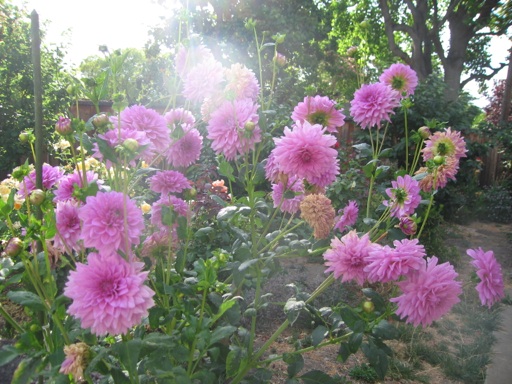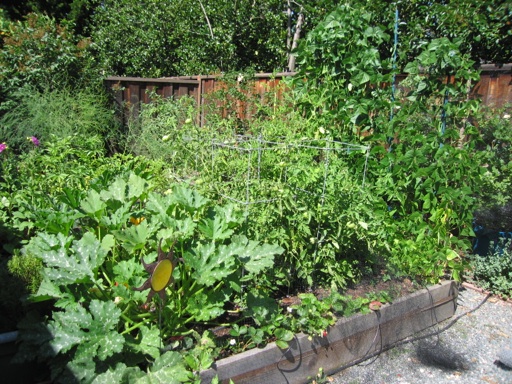Archive for the 'Pumpkin' Category
Our multi-grafted Japanese plum tree is full of plums right now. It’s a very small tree, about 5 feet tall and 4 feet wide. But it has over 100 plums on it. It has the most densely packed fruit of any fruit tree we have. It would benefit from thinning, because the branches can break under the weight of the fruit, but I didn’t bother to thin this year, because the fruit set was not as heavy as last year. The main grafts are the varieties Elephant heart and Laroda, which is the dark purple fruit in the picture below.
The tree also has a graft of Nubiana, which is very small and doesn’t grow much, and Beauty. Most of the Beauty graft broke off two years ago under the weight of a heavy load of fruit. I cut off the remaining branches of Beauty, because I didn’t care for its flavor. The Elephant Heart and Laroda grafts are not self-fruitful, but both have managed to set a lot of fruit two seasons in a row without pollen from Beauty. Pollen from our pluot tree and a neighbor’s plum have probably helped. The Beauty graft was huge and on the verge of taking over the tree. The Elephant Heart and Laroda grafts have grown a lot since Beauty has been gone.

I really enjoy growing sugar pie pumpkins and butternut squash. I have found that they are both easy to grow from seed as long as they get regular water. I planted several groups of seeds last March. The vines are very long now and have set many fruits, even though I haven’t fertilized them. The vines can take up a lot of space, which is why I planted the seeds where the vines can grow in between our fruit trees. I planted them directly in the ground, not in our raised beds, because the vines would just grow out of the beds and across our paths between the beds. Some of the pumpkins have even grown roots directly from the vines into the ground.


We are also growing Siam Queen (Thai) basil this year. I planted the seeds in pots in our mini-greenhouse in April and transplanted the seedlings into one of our raised beds in May. They only grow in warm weather, and it can get cold in April here. The plants grew slowly at first, but they are now starting to grow more rapidly. Their leaves have a strong scent that is similar to licorice, and their flowers are an attractive purple color. Also, they don’t seem to attract insects.

Our purple Dahlias have been full of flowers for several weeks. We are also growing them in raised beds where they get plenty of water and rich composted soil. Unfortunately, they are already getting mildew on their leaves, which happens every year around this time.

I planted corn seeds in mid-March this year, which is the earliest I have ever planted them. We almost never get frost here after March 1. I planted the peaches and cream variety, and ended up with about 18 plants. I always plant at least 15 corn seeds in a planting to ensure proper pollination. I started harvesting corn ears the first week of this month. They were very tasty.

I harvested some of the last ears today. Several of the stalks had two ears, and a few stalks grew outshoots that themselves grew an additional ear of corn. I have more corn in another bed that I planted in June. They should be ready to harvest in October.

I planted Albion strawberries in pots with potting soil in May. I had not grown this variety previously. I have been picking strawberries from the Albion plants for over a month now, and they have exceeded my expectations. They have been continuously producing very sweet and large berries. They are much sweeter than Chandler, which are on the tart side in our yard. I think I will be planting more Albion strawberries in the future. So far the Albion plants have not produced many runners, unlike our Sequoia strawberries, which are prolifically producing runners right now.

July 26 2014 | Basil and Corn and Dahlias and Plums and Pumpkin and Squash and Strawberries | Comments Off on Mid-summer post
As I mentioned in a preivous post, I am growing three different types of winter squash this year. The three photos below show the three different types: spaghetti squash (first photo), butternut squash (second photo), and sugar pie pumpkins (third photo).



I am growing winter squash directly in our dry clay soil. I added compost in a few of the holes when I planted the seeds, but the plants that got planted with compost are not growing any better than the ones that did not. I am watering each group of plants near their roots almost everyday with automatic microsprayers. Regular water seems to be critical to getting winter squash to grow long vines and large fruits. Everyday when the vines are exposed to direct sunlight for several hours, the leaves droop down. Watering doesn’t make the leaves perk up until the vines are shaded again. Other than lots of water, our winter squash doesn’t seem to need much care. I have not fertilized them. But because our soil is so dry, I don’t need to be concerned about the fruits rotting on damp soil.
Some people have commented that winter squash takes up too much room, because the vines can grow to 10 feet or more. I am growing winter squash in between our fruit trees. The vines grow around the fruit trees, and so they don’t take up much additional garden space. Although I have to be careful not to step on the vines when picking fruit.
August 01 2013 | Pumpkin and Squash | Comments Off on Winter Squash
Last March around the first of spring, I planted blue lake pole bean seeds and light and dark green zucchini seeds directly into one of our raised beds. I stared harvesting green beans and zucchinis in late May, and they have been producing prolificly since then. This year is the earliest harvest I’ve ever had for beans and zucchini. In the past, my green beans and zucchini didn’t mature until mid-June, and I have always planted them at the same time around the first day of spring. This year’s warmer weather was likely the cause.
Below is a photo of one of my raised beds that has pole beans growing on a wire support in the back, tomatoes in the middle in square cages, zucchini up front, and strawberries growing around the edge. This is the same bed shown in my Apr. 20 post. The plants are close together, which helps to prevent weed growth.

This is a close up photo of one group of my zucchinis:

My corn plants are also precocious this year. I planted corn by seed on Apr. 8 directly into another raised bed. The corn seeds took 2 weeks to sprout, but it has been growing rapidly since then. They already are pushing out the tassels.

I am experimenting with growing some new edible plants this year. Peanuts are one of the new plants I am growing this year. Peanuts are supposed to thrive in warm summers. I’m not sure it will be warm enough for them here, but I think that it will be fun to try at least once. I purchased peanut seeds through an online mail order website. I planted the peanut seeds in late April. The seedlings look like little pea plants. They are already generating small yellow sweet pea-like flowers. The photo below shows what they looked like earlier today.

I am also growing spaghetti squash, butternut squash, and sugar pie pumpkins this year for the first time. I planted all of these by seed. I planted the spaghetti squash and pumpkin seeds in late March outdoors in small pots and then transplanted them into the ground after they had sprouted. I decided not to plant them in our raised beds, because their vines grow so long that they would grow out of the beds and along the paths around the beds, which would force me to constantly step over the vines.
Our natural soil here is clay. Our neighbors grew pumpkins successfully in their clay soil last year, which inspired me to try them this year. The spaghetti squash and pumpkin vines are already several feet long and growing rapidly. The photo below shows two spaghetti squash vines with two spaghetti squash on them.

I am growing sugar pie pumpkins rather than jack-o-lantern pumpkins. I want to use pumpkins in cooking, and sugar pie pumpkins are bred for this purpose. Pumpkins are supposed to thrive in climates with relatively mild and dry summers, so they should grow reasonably well here. This is a photo of one of my pumpkin vines with a pumpkin on it:

June 15 2013 | Beans and Corn and Peanuts and Pumpkin and Squash and Zucchini | Comments Off on Vegetable Assortment
















